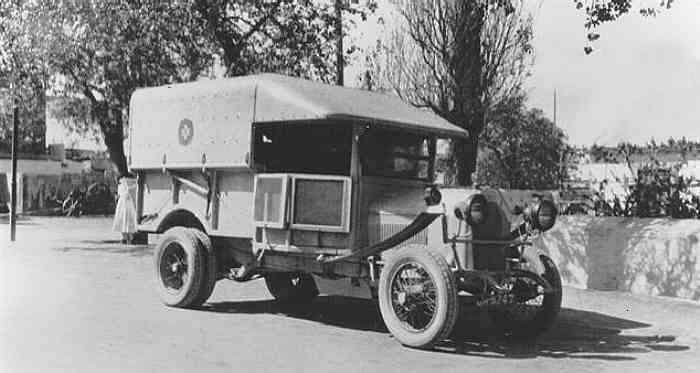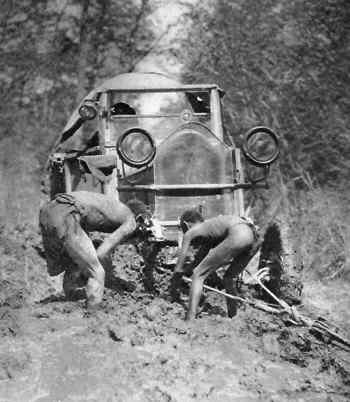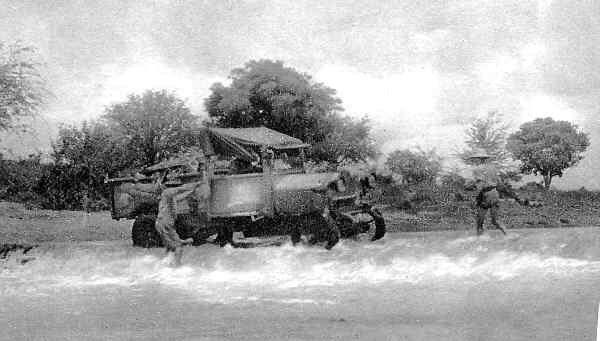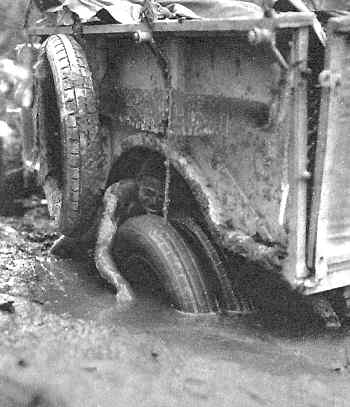The Court Treatt Expedition 1924-1926
The Expedition -
Part 1 Cape Town to Victoria Falls
Cape Town
The boat from England carrying the Court Treatts landed in Cape Town in the rain on Monday 15th September, 1924. Use of an old warehouse was arranged and the cars and other goods were taken there from the ship where they were joined by the rest of the expedition members. Food, fuel and oil were obtained locally and the vehicles packed. Anything not considered essential was condemned to a scrap heap. Chaplin Court Treatt, as expedition leader would drive one of the cars and the other would be shared between Errol Hinds and Fred Law. On the 23rd September everything was complete and it was time to depart.
South Africa

The mosquito nets over the side windows are folded down. (photo - Tony Courtney collection)
In front of a large crowd the expedition set off in the early morning in sunshine. The party consisted of the Court Treatts, Thomas Glover, Fred Law and representing the Crossley Motor company Captain F. C. Blunt and Mr McEleavey. The first day was on good roads and the first night was spent camping in some old stables at Bain's Kloof (Baynes Kloof in Stella Court Treatt's book) high in the Boland mountains after covering a distance of about 50 miles (80 km).
The next day involved the first river crossing when the Breide had to be forded and this involved the first mishap when one of the cars lost its undershield on a rock and had to be dragged out by a team of donkeys. After the climb the country leveled out as they entered the Karroo, a high flat area, but good roads continued and they were able over the next few days to cover good distances only handicapped by lots of dust and a shortage of firewood.
In the Karroo there occurred one of those incidents that can still happen in Africa today. Mrs Court Treatt decided that her new trench coat was far too bulky and cumbersome so abandoned it only for on the next day to be stopped by a man and presented with the same coat carefully wrapped in brown paper. Kimberley was reached on Thursday 2nd October with around 650 miles (1000km) now completed.
Two days after leaving Kimberley the group had their first breakdown when an axle shaft broke. As they were near the railway a replacement was ordered from the spares dump at Johannesburg causing a delay of a week before it arrived and was fitted. They were then on their way again and a few days later arrived in Johannesburg to be met by a welcoming party from the local Automobile Club. The two Crossley representatives left the party to be replaced by Errol Hinds and Julius Mapata. After a short break to re-organise the packing and obtain some fresh provision they were off again on Saturday October 25 and into the farming country of the Northern Transvaal.
On 2 November they crossed the nearly dry Limpopo river and entered Southern Rhodesia (Zimbabwe). Border crossings merit no mention in the book so formalities in those days must have been minimal to non existent.
Southern Rhodesia (Zimbabwe)

The entry into Matabeleland seems to have caused excitement for here they entered big game country and each night a hunting expedition seems to have been mounted though without "success" until Thomas Glover managed to shoot a hippo the meat of which was given to the local people. The first lion was spotted on November 5 but the excitement was partly overshadowed by the party running out of cigarettes. The weather was changeable with some rain, a sign that the rainy season was approaching, earlier than expected. The ruins of Great Zimbabwe were reached on November 12th and a short break was taken there to check over the vehicles and sort and mend clothing and camping equipment. Setting off again they headed for Victoria (Masvingo) on good roads and in spite of getting stuck in the mud once, a portent of what was to come, carried on to Bulawayo which they reached on Tuesday November 25th. They had decided that they would camp whenever possible so shunned the hotels of Bulawayo and settled on the showground a few miles out where they stayed for some time to, among other things, rebuild the back axle on the second car and have a trailer built. While camped the rains continued heavily just as they were to attempt a part of the route that had never been traversed by a motor car.
This would be their last treat for a while as to save more weight the food was cut down and from now on it was to be Bovril, bully beef, salt, tea and coffee, meal and dried fruit. To reduce the weight of the vehicles further the roof sections and the new trailer were abandoned at Nyamandhlovu 30 miles (50km) north west of Bulawayo on December 28th. The vehicles were now covered by tarpaulins which did not keep the continuous downpours out and everything was soaked.
The next 380 miles to Victoria Fall, following roughly the route of the railway, would take four months. Just north of Bulawayo they met the mud in serious quantities and started a routine of traveling a few yards, sinking in, digging out and repeating the process. A good day would mean traveling six miles. It rained continuously soaking everything and was also so humid that nothing dried in spite of the heat. Camping was a miserable experience. Christmas was celebrated with a hot meal, a cake, plum pudding with flaming brandy and champagne drunk from tin mugs, all in the rain under a soaking tent.

The Gwaai (Gwayi) river was reached on January 2nd 1925 and it was in flood and had steep inclines down to it and out the far side. The crossing was attempted on the morning of the 3rd. The first car was driven down and got stuck leaning at a precarious angle. Fortunately, at the far side was a settler with a span of oxen and these were borrowed to pull the car back out and allow a second attempt. It was also discovered that they were attempting to cross on top of a submerged dam and so only had a narrow path to find on the river bed.
Beyond the river they tried abandoning the road and with a local guide tried heading across country on higher ground which meant clearing a track through the bush which reduced progress to below walking pace but the railway settlement of Gwaai (Gwayi) was eventually reached on January 8th. Here, camped not far from the railway line they could watch the Victoria Falls Mail train pass with a glimpse of the passengers dining at tables covered in spotless linen.
After Gwaai they had the choice of continuing alongside the railway or
heading off to a place called Jowitt's Farm and chose the latter as it
was on higher ground. The ascent was made easily under their own power
and good progress was made until after 15 miles and after about 3 hours
they reached the marshland of the Impindo. The marsh or vlei was about a
mile and a half across, flooded and full of leeches and to get across
they had to pile logs under the wheels, but even with this the cars
constantly sank into the mud.
On the 20th January, running short of food and fuel they reached the
farm of a Mr Chatham and took the opportunity to rest and do some
washing. After a few days they were off again and back into the bogs
then on 27 January they regained the railway at Dett (Dete).

In spite of reports that the road from Dett to Wankie (Hwange) was good and was in theory possible to cover in a day, it actually took a month. The track through the bush was deep mud again and now there were also many small rivers to cross. Oxen had to be hired to pull them out on several occasions but eventually travel got totally impossible so they camped up for three weeks and wait for conditions to improve. The frustration must have been very great as they could get messages to Wankie and even received newspapers and posted letters but the ground was so bad that a mile a day with the cars was good progress. Oxen and block and tackle to haul the cars were used as much as engine power. The coal mining centre of Wankie was eventually reached on the 2nd March.
They remained in Wankie for around ten days enjoying the facilities of the club and allowing Thomas Glover to visit the hospital for treatment to an abscess on his leg. The hospital was visited again when Errol broke his arm when crank starting one of the cars and it was decided that he would stay there while it set and re-join the party at Victoria Falls by catching a train.
They had good weather during their rest stop but on setting off again on March 20th the rains also re-commenced and it was back to digging through the mud. In an attempt to find better ground they again left the "road" and headed uphill into the bush and now had to make a pathway which involved, with the help of local workers, cutting down up to a hundred trees a day and removing the stumps. A few days rest were spent at the farm of a Mr Robbins before continuing over a slightly better road and over the Dekka river to to another farm belonging to Mr Crewe with the cars having to be dragged by oxen the last few miles. After two days they continued again with the help of oxen to the next farm of Mr Cumming, a big game hunter. This was near Matetsi where one of the fuel and spares dumps was and a wagon pulled by sixteen oxen was sent for fuel.
It was off again on the 20th April and although the worst of the rains
was over the road was still hard going but one day a cloud could be seen
on the horizon and Victoria Falls was in sight and reached on
Monday 27th April 1925.